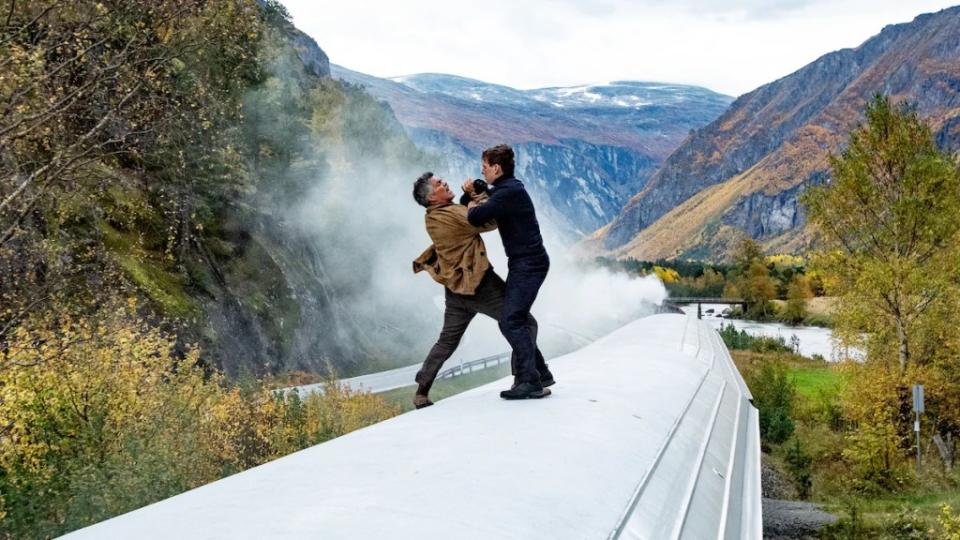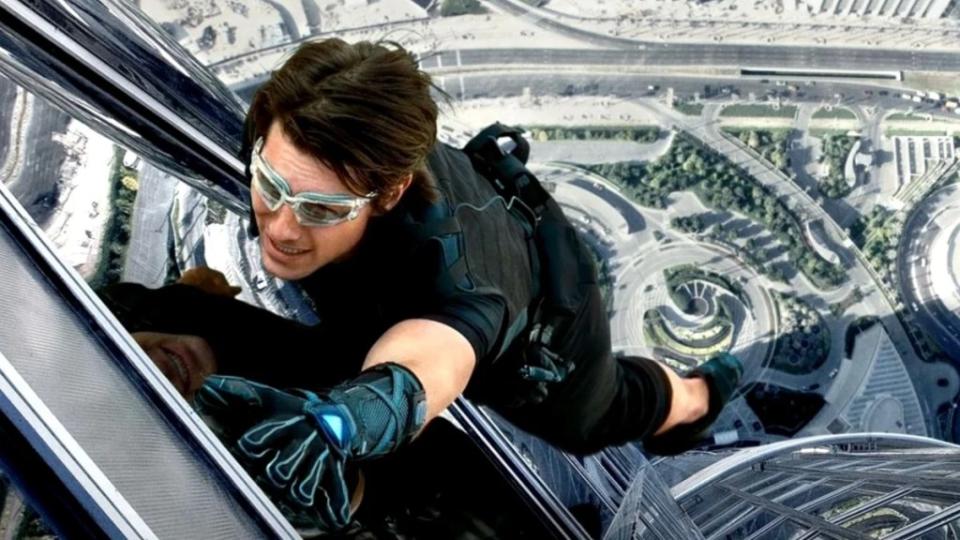Insuring Tom Cruise: Computing Cost of DIY Stunts Is a Hollywood Mission Impossible
- Oops!Something went wrong.Please try again later.
- Oops!Something went wrong.Please try again later.
In a surprise to basically no one, Tom Cruise rides a motorbike off a cliff in the summer blockbuster “Mission: Impossible — Dead Reckoning Part One,” which was released in theaters this summer after three years of stop-and-start production and is now beginning its life on home video. The action superstar insists on doing his own stunt work, and has been talking about it since 1996, the year the first “Mission: Impossible” movie came out. In each successive movie, the stunts have gotten more intense: hanging off the tallest building in the world, attaching himself to the outside of an airplane while it takes off and flying his own helicopter through a treacherous mountain range.
But trying to quantify the cost to insure the action star can be a Hollywood Mission Impossible.
To be sure, Cruise’s risky exploits can raise the overall insurance cost for a film — creating a sort of Cruise Factor for assessing a film production’s risk — as regular cast coverage “does not take into account the type of extreme hazardous activities that Tom Cruise does, like a free fall out of a plane,” Dominique Butler, assistant vp of entertainment at broker NFP Property & Casualty Insurance Services, told TheWrap. “God forbid if he is injured or killed. Then you are walking away from that project.”

Cruise control?
The producers of “Mission: Impossible” apparently reckoned Cruise would live through “Dead Reckoning Part One,” since Part Two is in the works for a summer 2024 release and 40% of the sequel is already in the can.
Paramount Pictures did not respond to requests for comment on the insurance issue as it pertains to Cruise.
The actor’s daredevil tendencies tend to become a part of the marketing for films in the franchise, and sites regularly rank his top stunts. In “Dead Reckoning,” Cruise dangles from a train and rides a motorbike off a 7,000-foot cliff in Norway — the actor becomes a living Cruise missile flying off the bike in free fall and then gracefully parachutes to Earth.
This is not to say that no movie magic takes place in creating the spectacular visuals in Cruise movies, including the various “Mission: Impossible” films, 2022’s “Top Gun: Maverick” or “Jack Reacher: Never Go Back” (2016). But it seems safe (or rather, really unsafe) to say that whatever a stunt double would do, Cruise usually does — and more.
Though other stars have done stuntwork — including Tom Holland, Charlize Theron and 81-year-old Harrison Ford in 2023’s “Indiana Jones and the Dial of Destiny” — somehow Cruise’s exploits more consistently end up in the limelight. So do his insurance issues: Skydance CEO David Ellison said that Cruise demanded that producers fire one insurance company for refusing to provide coverage for the actor’s plan to hang off the side of a skyscraper in “Mission: Impossible — Ghost Protocol.”
Matt Damon once asked Cruise about the skyscraper stunt. “So, I go to the safety guy and tell him, ‘This is what I’m going to do,'” Damon recalled Cruise telling him, as recounted to Conan O’Brien in 2019. “‘The safety guy says, ‘You can’t do that, that’s too dangerous’….So I get another safety guy.'”
While no one with access to the numbers will speak to Cruise’s individual insurance costs without risking their jobs, total insurance costs for any film – referred to as Production Package insurance — ranges from about 1% to 2.5% of a production budget, Marc Idelson, CEO of entertainment insurance company Reel Media, told The Wrap. A Production Package typically covers cast; third party property damage; props, sets, wardrobe and miscellaneous equipment. By TheWrap’s calculations, that would place insurance costs for the latest “Mission: Impossible,” which has a budget of $291 million, at between $2.9 million and $4.4 million.
In rare cases, when an insurance company is not willing to cover something under the normal Production Package policy, the producers may have to pay higher premiums under a separate policy. Such a policy could include stunts, pregnancy, stop-date issues, hurricanes, the piloting of planes and numerous other situations, Idelson told TheWrap.
“In most cases, we try to find a solution under the Production Package policy which could result in an additional premium cost,” Idelson added. “However, it is not uncommon that separate policies are put in place to cover exclusions under the Production Package policy. Those separate policies may carry much-higher rates, but it is usually charged against a lower limit rather than the full budget (a sub-limit) of $1 million to $10 million depending on the situation.”
Butler said Cruise’s risky exploits likely require additional insurance that only specialty carriers like Lloyd’s of London will provide, and it can cost 5% to 20% of policy limits and require a deductible of up to 10% to cover a film’s full budget (so potentially a $20 million deductible for a $200 million film).

In calculating insurance costs for any individual performer, companies assess risky stunts in a complicated equation that includes age, health and lifestyle off the set, including such activities as extreme sports or flying private planes (Cruise is a certified pilot), Idelson said. An actor with a substance abuse problem or general track record as a no-show can delay a production as easily as an actor injured in a stunt. (Insurance companies also insure other people important to the day-to-day production, such as the director, in their own categories).
Stunt “doubles”
For a franchise like “Mission: Impossible” — or any action movie with a planned sequel — stunts for multiple movies are often done concurrently. “What the insurance companies want in most situations is for them to pull all the stunts forward…because we don’t want them to be halfway through filming and then someone gets hurt,” Idelson said. “If it happens early on, it’s still a problem, but less of a problem.”
Cruise famously broke his ankle jumping from rooftop to rooftop during the filming of “Mission: Impossible – Fallout,” which resulted in a nine-week shutdown of production that added millions to the budget — millions that were covered by insurance.
Tim O’Hair, a film executive, producer and financier who also teaches at Chapman University, told TheWrap that if a project is pre sold on the shoulders of particular talent — which could be a recognizable star or a filmmaker — the distributor may require assurance that the picture is delivered with that talent, who may be deemed an “essential element” contractually. “Getting an essential element insured can lead to an increased cost for underwriting, as the picture cannot be delivered without the named element,” O’Hair said. “Producers don’t love this, but it’s an understandable part of insurance necessary to fund presales.”
In the end, overall insurance costs depend not just on the cast and its activities but a wide range of factors that might shut down production, either temporarily or permanently. “There’s a whole array of things that could go wrong,” Idelson said.
There’s a whole array of things that could go wrong
Marc Idelson, Reel Media
Brian Kingman, a managing director of Gallagher Entertainment, which provides brokerage and risk management services to the entertainment community, ticked off a list of those possibilities: a fire on the set, bad weather, equipment damage, political upheaval on location and possible accidents involving planes or boats if the story line calls for those.
“We provide insurance products for just about every unaffordable or unwanted risks associated with film or film creation, television creation and production,” Kingman said. (It should be noted that Gallagher Entertainment was not involved in “Mission: Impossible — Dead Reckoning Part One.”)
The COVID-19 pandemic cost studios and insurance companies way more than Cruise ever did, no matter how crazy the stunts. “The insurance companies lost hundreds of millions of dollars, maybe more,” Idelson said. In fact, COVID-19 restrictions and mandatory quarantines delayed completion of “Dead Reckoning” parts One and Two, not Cruise once again jumping off of something really, really tall.
Whatever the cost of the Cruise Factor, producers apparently believe it’s worth the price. “If you want to be in business with him, you kind of have to let him do what he wants to do,” O’Hair said.
Alexei Barrionuevo contributed to this story.
The post Insuring Tom Cruise: Computing Cost of DIY Stunts Is a Hollywood Mission Impossible appeared first on TheWrap.

